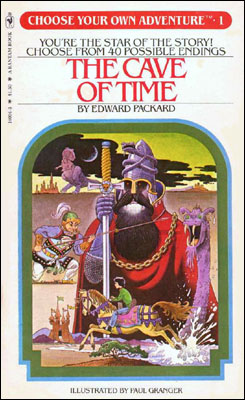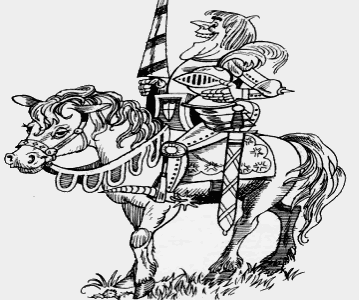This week, I wanted to take a look at another venerable RPG can of worms: Alignment.
While the definition of "Alignment" in role-playing games is by no means settled, it usually boils down to some flavor of "personal belief system" for the PCs. As one might expect, attempting to inject morality into role-playing has been and continues to be controversial and hotly debated! Furthermore, it can lead to confusion and divisive behavior and/or results at the game table.
Like many topics in role-playing games, the story of Alignment begins with Original Dungeons & Dragons (1974), which states:
Unsurprisingly, the creatures in the Fantasy Supplement to Chainmail (1971), the miniatures war-game that provided much inspiration to OD&D, were similarly divided into "Law," "Neutral," and "Chaos." OD&D's chart of creatures' Alignments that mostly follows Chainmail's chart. Thus, given OD&D's wargaming roots (as well as the first adventures being dungeon crawls), it's easy to see why the designers thought in terms of competing teams or sides.
However, by 1974, OD&D went beyond a simple "shirts v. skins" approach and co-opted ideas from Poul Anderson and Michael Moorcock about cosmic scale "teams" of primeval forces of Law and Chaos in a perpetual struggle. This shows up most concretely in those wacky Alignment Languages:
Alignment Languages were meant to be secret languages for these "cosmic" teams. So, all Lawful dudes everywhere speak the same secret language because Reasons.
Even Gygax later acknowledged that this was a bridge too far:
In any event, if you like the literary foundations, the OD&D version of Alignment is fine, but I suspect many people simply ignored this forced narrative conceit. Moreover, while morality is not expressly set forth in Chainmail's proto-Alignment system, a moral element is more strongly implied in OD&D than in Chainmail, since creatures like unicorns are Lawful and creatures like vampires are Chaotic and after elves were moved to Lawful.
When Gygax starts explicitly interjecting "objective morality" a couple years later and making Alignment more central to a D&D-esque fantasy setting, the concept really starts going off the rails. In the February 1976 issue of Strategic Review, Gygax writes:
Eventually in the same article, Gygax sets forth a new five-fold alignment system:
This five-fold alignment system is adopted the next year in Holmes Basic D&D (1977):
Alignment is far more baked into the game system in Holmes Basic than OD&D. For example, and here we find the first instance of the first instance of Know Alignment spells.
In addition, the stakes regarding Alignment are notably higher, since here we find the first instance of XP penalties for out of alignment gameplay in Holmes Basic. Even in cases of honest misunderstanding or disagreement, the chance of problems, if you are playing the Rules As Written, have just increased notably.
So, for better or worse, Alignment is now a thing in D&D. Are things about to get wonkier? Stay tuned!
While the definition of "Alignment" in role-playing games is by no means settled, it usually boils down to some flavor of "personal belief system" for the PCs. As one might expect, attempting to inject morality into role-playing has been and continues to be controversial and hotly debated! Furthermore, it can lead to confusion and divisive behavior and/or results at the game table.
Like many topics in role-playing games, the story of Alignment begins with Original Dungeons & Dragons (1974), which states:
"Character Alignment, Including Various Monsters and Creatures: Before the game begins it is not only necessary to select a role, but it is also necessary to determine what stance the character will take - Law, Netrality[sic], or Chaos."
Unsurprisingly, the creatures in the Fantasy Supplement to Chainmail (1971), the miniatures war-game that provided much inspiration to OD&D, were similarly divided into "Law," "Neutral," and "Chaos." OD&D's chart of creatures' Alignments that mostly follows Chainmail's chart. Thus, given OD&D's wargaming roots (as well as the first adventures being dungeon crawls), it's easy to see why the designers thought in terms of competing teams or sides.
However, by 1974, OD&D went beyond a simple "shirts v. skins" approach and co-opted ideas from Poul Anderson and Michael Moorcock about cosmic scale "teams" of primeval forces of Law and Chaos in a perpetual struggle. This shows up most concretely in those wacky Alignment Languages:
"Law, Chaos and Neutrality also have common languages spoken by each respectively."
Alignment Languages were meant to be secret languages for these "cosmic" teams. So, all Lawful dudes everywhere speak the same secret language because Reasons.
Even Gygax later acknowledged that this was a bridge too far:
"As D&D was being quantified and qualified by the publication of the supplemental rules booklets. I decided that Thieves' cant should not be the only secret language. Thus alignment languages come into play, the rational [sic] being they were akin to Hebrew for Jewish and Latin for Roman Catholic persons.
I have since regretted the addition, as the non-cleric user would have only a limited vocabulary, and little cound [sic] be conveyed or understoon [sic] by the use of an alignment language between non-clerical users."
In any event, if you like the literary foundations, the OD&D version of Alignment is fine, but I suspect many people simply ignored this forced narrative conceit. Moreover, while morality is not expressly set forth in Chainmail's proto-Alignment system, a moral element is more strongly implied in OD&D than in Chainmail, since creatures like unicorns are Lawful and creatures like vampires are Chaotic and after elves were moved to Lawful.
When Gygax starts explicitly interjecting "objective morality" a couple years later and making Alignment more central to a D&D-esque fantasy setting, the concept really starts going off the rails. In the February 1976 issue of Strategic Review, Gygax writes:
"Many questions continue to arise regarding what constitutes a “lawful” act, what sort of behavior is “chaotic”, what constituted an “evil” deed, and how certain behavior is “good”. There is considerable confusion in that most dungeon- masters construe the terms “chaotic” and “evil” to mean the same thing, just as they define “lawful” and “good” to mean the same. This is scarcely surprising considering the wording of the three original volumes of DUNGEONS & DRAGONS...In fact, had I the opportunity to do D&D over I would have made the whole business very much clearer by differentiating the four categories, and many chaotic creatures would be good, while many lawful creatures would be evil."
Eventually in the same article, Gygax sets forth a new five-fold alignment system:
This five-fold alignment system is adopted the next year in Holmes Basic D&D (1977):
Alignment is far more baked into the game system in Holmes Basic than OD&D. For example, and here we find the first instance of the first instance of Know Alignment spells.
In addition, the stakes regarding Alignment are notably higher, since here we find the first instance of XP penalties for out of alignment gameplay in Holmes Basic. Even in cases of honest misunderstanding or disagreement, the chance of problems, if you are playing the Rules As Written, have just increased notably.
So, for better or worse, Alignment is now a thing in D&D. Are things about to get wonkier? Stay tuned!












